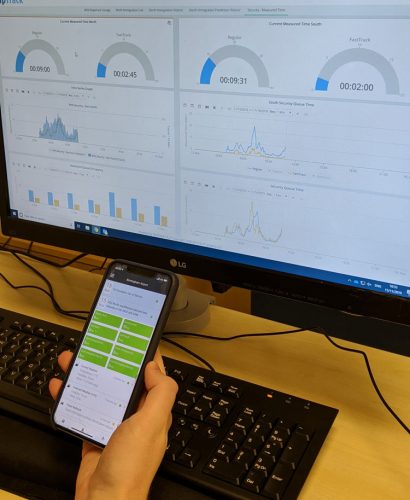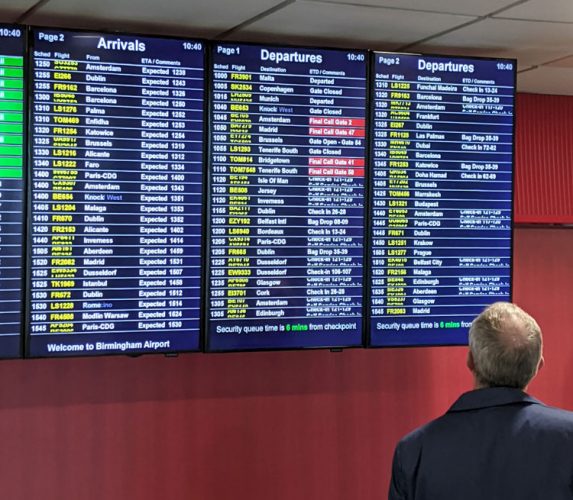Door-to-departure flow management transforms Birmingham Airport
- Like
- Digg
- Del
- Tumblr
- VKontakte
- Buffer
- Love This
- Odnoklassniki
- Meneame
- Blogger
- Amazon
- Yahoo Mail
- Gmail
- AOL
- Newsvine
- HackerNews
- Evernote
- MySpace
- Mail.ru
- Viadeo
- Line
- Comments
- Yummly
- SMS
- Viber
- Telegram
- Subscribe
- Skype
- Facebook Messenger
- Kakao
- LiveJournal
- Yammer
- Edgar
- Fintel
- Mix
- Instapaper
- Copy Link
Posted: 14 January 2020 | Veovo | No comments yet
Birmingham Airport (BHX) has long been recognised as one of the UK’s most punctual and family-friendly travel hubs. The four-time winner of the prestigious Star UK Airport prize loves keeping its customers happy. However, with passenger numbers rapidly rising, the airport realised it needed a new way to keep things running smoothly.


As a long-time partner of Veovo for airport and queue management, Birmingham Airport (BHX) decided to expand its solution to gain cohesive insights into how customers move and use facilities from arrival to departure.
We caught up with BHX’s Terminal Operations Project Coordinator, Giles Baldwin, to find out how moving from single-process queue measurement to airport-wide flow management is improving staff resourcing, bottleneck prevention and expansion planning.
More passengers, more challenges
Choosing a partner
Like many of its contemporaries, Birmingham Airport has experienced rapid growth over the last few years, handling over 12 million passengers in 2018 alone. Following the successful 2016 implementation of Veovo’s queue measurement solution in its processing areas, as well as their airport management (AODB and FIDS) solution, expanding the relationship seemed a natural choice.
“We needed to understand the nature of passenger flow throughout the terminal,” said Baldwin. “This meant finding technology that offered a high-ratio passenger capture rate, no matter the physical layout. We also needed a platform that could make sense of the data it was collecting and deliver it in a way that we could use it to make smart decisions.”
The inefficiency of manual measurements


“This not only tied up staff, but checks were time-consuming and offered no scope to plan, manage or reduce delays. We were relying too much on assumptions. Following the implementation of the queue measurement solution in 2016, the results were indisputable – a near-trebling of data capturing capabilities, as well as the ability to keep passengers informed and relaxed, by displaying accurate wait times in our processes.”
As a result, Birmingham Airport recently decided to expand the now-proven partnership.
“We wanted to gain a more in-depth behavioural understanding across all processes, to optimise resources and throughput speed, increase revenue opportunities and provide optimum passenger experiences.”
Seeing the bigger picture of operations
The all-knowing airport
With the expansion to airport-wide flow management, BHX now receives detailed insights around customer occupancy, dwell time and movement patterns, both in individual areas, as well as holistically. It offers a seamless understanding of the interconnections between customers, airlines and processes, providing instant situational awareness across the airport ecosystem.
“We’re now not only able to view what’s happening as it happens 24/7, but we can also compare current operations against expectations. It allows us to optimise the entire customer journey, rather than sub-optimising isolated areas.”
Reaping the benefits
Despite the increase in passenger numbers, movement insights have already helped reduce security queue length by 10 per cent year-on-year. In response, BHX has adjusted its KPIs to ensure they are on a journey of continuous improvement.
“The wait-time reduction was achieved by focusing on optimisation. Operational teams use the solution to view real-time data, allowing them to make informed decisions and continuously improve their customer journey. With Veovo´s sensor-agnostic approach – which leverages both existing and new sensors, as well as third-party sources – they can also compile up-to-date forecasts to help with future planning.”
The upside of combining flow and flight information
The ability to create flight schedule-based forecasting is improved by the tight integration between Veovo´s passenger flow and operations platform, used by the airport to manage resource planning and improve day-of-operation decision making.
“By combining movement and AODB data, we can now analyse flow patterns alongside flight schedule information. It allows us to study trends by airline, time of day and destination, and evaluate their in-terminal effects, including show-up profiles and dwell times at processes.”
The insights enable BHX to create dynamic live operational flow forecasting, allowing for rapid resource adjustment to adapt to changes. It also allows for real-time operational resource adjustment, to meet safety service level agreements, manage customer experiences and communicate effectively.
Using forecasting to improve flow, health and safety
“Forecasting plays a crucial role in decision making in relation to our future expansions, ensuring we match future capacity with demand, as well as complying with health and safety regulations.”
At present, BHX uses live situational data that raises an alarm when occupancy is approaching its limits; and historical data analysis to understand what impact passenger levels have on the main dwell areas at different times of the day. With improved forecasting and real-time capacity visualisation, terminal occupancy is more effectively managed.
“For instance, if the departure lounge is approaching capacity, we can use tactics such as ‘call to gate’ to redirect travellers – using the Veovo FIDS – to go to the gate area, reducing the lounge headcount. We can also use historical data to understand how occupancy affects lounges, concessions and rest areas at various times of the day. We can even measure the number of people using escalators and lifts, allowing us to make proactive preventive maintenance plans.”


Planning the future at Birmingham
Valuable insights to help expansion
As BHX continues to grow, the airport plans to explore the varied capabilities to improve its operations.
“We´re exploring using prediction more, especially in the boarding process, and its impact on the on-time performance of an aircraft. There is a multitude of areas Veovo could add value to, and we have only scratched the surface of the multiple benefits of the solution.”
“We recently published the masterplan for Birmingham Airport. During this time, we will develop and invest in our facilities to handle the expected 40 per cent growth. Vital to this programme is a deep understanding of capacity and constraints on a larger scale. Veovo is the key to providing us with more quality data of our passengers using the terminal.”
In the short term, BHX is exploring new use cases, such as detecting the location and movement of assets like trollies, employees and vehicles, and determining what improvements are needed. The airport is also considering how best to leverage Veovo’s new advancements in 3D sensors to improve measurement precision at key choke points.
The global picture
Amsterdam Schiphol, Bristol, Keflavik and Billund airports have also moved beyond single-process measurement and implemented flow management to help build resilient operations, optimise capacity, maximise revenue and deliver brilliant customer experiences. In New Zealand, Auckland Airport has even expanded the system, by partnering with road traffic authorities, to provide coherent insights from the city centre to the gate.


Related topics
Airport Collaborative Decision Making (A-CDM), Airside operations, Passenger volumes, Terminal operations

















